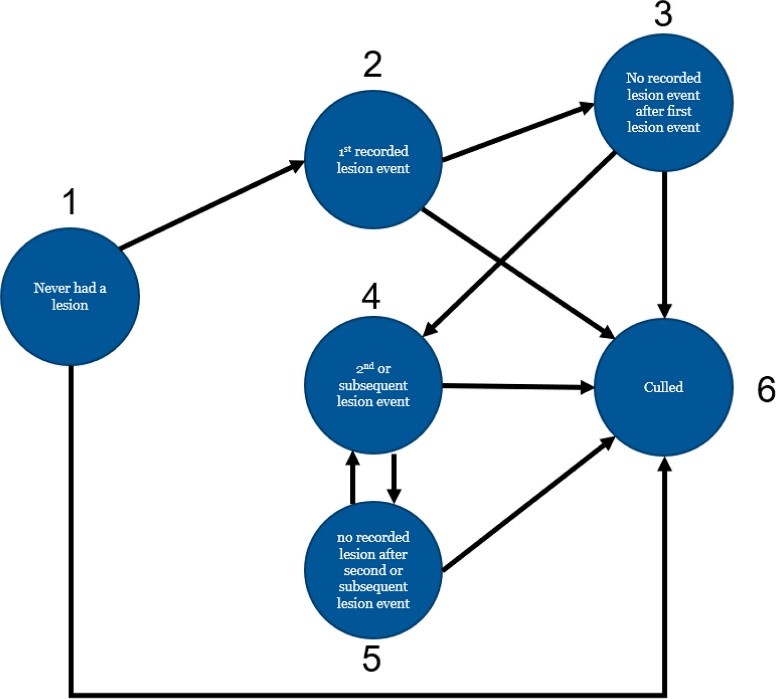- Home
- Research bites: When modelling takes on a new meaning
Research bites: When modelling takes on a new meaning
Research from the University of Nottingham sheds new light on modelling feet but it isn't quite the type of model-talk that we're used to. Researchers have applied some of the principles applied to mastitis cases and this time looked at including claw horn lesion data into statistical models to see what we can learn. So what can this type of modelling tell us?
The study design
The study focused on claw horn disruption lesions (CHDLs) and used foot trimming data from 57,974 cows across 1,332 herds in the Netherlands to try to understand more about the long-term effects of claw horn disruption lesions i.e., sole haemorrhage, sole ulcer and white line disease.
Various criteria were assigned to the inclusion of data e.g., trimming events no more than 12 months apart and the absence of infectious causes of lameness at inspection. Additional data such as lesion severity, age at first calving, parity, breeding value, locomotion and days in milk at time of foot trimming were also recorded.
The researchers then used a form of modelling referred to as 'multistate' which effectively looks to predict the time before a cow transitions from one state to another e.g., no lesion to a lesion being present. In this case they used 6 different 'states' (see Figure One below for interaction between the different states):
- Never had a lesion
- First recorded lesion event ('new case')
- No recorded lesion event after first lesion event ('recovered case')
- Second or subsequent lesion event ('repeat case')
- No recorded lesion after second or subsequent lesion event ('recovered after repeat')
- Culled
Figure One: Six-state model used to fit data in the study. Lesion events began when one of three claw horn disruption lesions were recorded, and end when a recording is made where none of these lesions are present.

What did the results show?
The modelling showed that cows who had more severe first lesions had a higher chance of having future CHDLs recorded (Stage 4) compared to those that had a mild first lesion. However, they expand on the earlier findings of Randall et al. (2016) who suggested mild lesions may be protective and suggest that these 'protective' effects last for an extended period of time. Similarly, the detrimental effect of a severe lesion is also long lasting.
There was increasing risk of lesion occurrence with increasing parity, and this again supports previous findings. Interestingly they suggest that cows in first lactation are more at risk of presenting with a lesion compared to parity 2 or 3+ cows that had never presented with a lesion (stayed in State 1). This reaffirms the importance of focusing attention on first lactation animals.
The timing of the first lesion event i.e., ≤180 vs >180 days in milk, was also interesting. Those presenting with a first lesion ≤180 days in milk were more likely to move to a no lesion state (State 3) sooner than those presenting >180 days. The authors hypothesise that this could be a reflection of the underlying cause of the lesion and whether it was a result of the calving process. It could also reflect the impact of a delay in identification and treatment of lesions which we know affects chances of recovery.
Type of lesion at first event also affected outcome; those with sole haemorrhage had an extended time to a second lesion event (State 4), whereas sole ulcers and white line disease led to an increased frequency of lesion events.
Overall, the modelling was used to classify cows as high- or low-risk. High-risk cows were classified as those with an age at first calving of more than 26 months and breeding values in lowest quartile. Conversely low-risk cows were classified as those with an age at first calving of less than 23.6 months and breeding values in the highest quartile. On average the results indicated that low-risk cows present with a lesion on average three months later than high-risk cows.
The impact of breeding value at herd level was further explored using simulated models. Herds in the highest quartile indicated that cow present with a CHDL on average 7.5 months later compared to herds where breeding values were found in the lowest quartile. This confirms what we've learnt through the recent research into the link between genetics and lameness.
What difference does this make in the field?
Although there are a number of limitations to the study including interval between trimming events (median five months) and potential for foot trimming technique to mask sole haemorrhage (if a more traditional model was implemented for Step 3), this study supports a number of observations from the field.
It provides more evidence of the need to focus on heifers for longer term lameness success. Attention needs to be paid to ensuring that they calve in at an average of 24 months and are managed appropriately both before and after calving to minimise the risk of lesion development. Often heifers are mismanaged or overlooked yet it is this group that really needs to be considered the most important.
Keeping as many first lactation animals sound throughout their entire lactation is a key performance indicator that should be used more and this study supports this. For MMs analysing mobility scores, paying particular focus on the first lactation animals can be a useful way of monitoring this.
It is also this group that is likely to benefit from interventions to a greater extent than older cows with a history of lameness.
*References:
Randall, L. et al. (2016) Lameness in dairy heifers; impacts of hoof lesions present around first calving on future lameness, milk yield and culling risk. Prev. Vet. Med. 133: 52-63. https://doi.org/10.1016/j.prevetmed.2016.09.006

